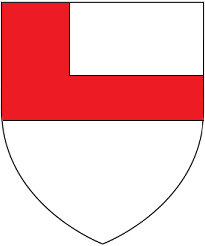Richard Wydeville (died 1441) facts for kids
Richard Wydeville (also known as Wydville or Woodville) was an important English person who lived a long time ago. He was a landowner, a soldier, a diplomat, and a politician. His son married an aunt of King Henry VI. This son and his wife then became the parents of the woman who married the next king, Edward IV. This means Richard Wydeville was the great-grandfather of a queen!
Contents
Who Was Richard Wydeville's Family?
Richard Wydeville was the younger son of John Wydeville. John was a landowner in Northamptonshire and worked as an administrator and politician for many years. Richard's mother was John's second wife, Isabel.
The Wydeville family had lived in the village of Grafton Regis since at least 1268. They owned the manor house there. Richard also got land in Kent at a place called Mote Park in Maidstone.
What Did Richard Wydeville Do?
Richard Wydeville had a busy career serving England.
Early Military Service
By 1411, Richard was a soldier in France. He was part of the English army in Guînes, which was near Calais. He served under the Duke of Clarence, who was King Henry V's brother.
In 1415 and 1417, Richard was a captain in King Henry V's army fighting in France. Later, he worked for another of the King's brothers, the Duke of Bedford.
Important Roles in France
Richard was given many important jobs in Normandy, France. In 1421, he became the Seneschal of Normandy. This was a very high position, like a chief officer.
By 1423, he was the Duke of Bedford's Chamberlain. This meant he managed the Duke's household. He was also the Treasurer of Normandy, managing money, and the Captain of the city of Caen.
Serving the King and Country
In 1425, Richard was sent to London to protect the Tower of London after some trouble. The next year, in 1426, he was part of a group sent to talk with Philip III, Duke of Burgundy.
In 1427, he became the Lieutenant of Calais, another important military role. In 1431, he was chosen to protect the young King Henry VI while the king was in France.
Political Life in England
In 1433, Richard was chosen to be a Member of Parliament for Kent. He also became a justice of the peace for the county. This meant he helped keep law and order.
In 1434, he attended a big meeting in Westminster. Here, the Duke of Bedford and his brother, Humphrey, Duke of Gloucester, argued about the war in France. After this, Richard was called back to fight in France.
While Richard was part of the council, his son, also named Richard, met the Duke of Bedford's French wife, Jacquetta. After the Duke died, Richard's son married Jacquetta.
Later Career and Death
In 1435, Richard was again made Lieutenant of Calais. He was also chosen to lead talks with other European groups like the Duchy of Burgundy.
Richard's brother, Thomas, died in 1435 without children. Thomas left most of his land to his sisters. However, Richard inherited the family's main manor at Grafton. He had some legal arguments about his brother's will for the rest of his life.
In 1437, he became the Constable of Rochester Castle. Later that year, he was chosen as the High Sheriff of Northamptonshire. He also worked on a special group there in 1439.
Richard Wydeville made his will on November 29, 1441. He died soon after and was buried in Maidstone. Even though he served the country and was connected to the royal family, he was never made a knight.
Richard Wydeville's Family Life
Richard Wydeville was married to a woman named Joan. She was the daughter of Thomas (or John) Bedlisgate from Knightstone in Devon.
They had two known children:
- Richard (died 1469): He married Jacquetta, who was the widow of the Duke of Bedford. This Richard was later given the title of Earl Rivers. Their daughter, Elizabeth, became the queen consort of King Edward IV. This means Elizabeth was the queen of England! She is an ancestor of all English monarchs from 1509 onwards and Scottish monarchs from 1513 onwards.
- Joan (died 1462): She married William Haute, who was also a Member of Parliament for Kent.
Richard's wife, Joan, died sometime after 1448. She was probably buried in Maidstone, too.
Images for kids



